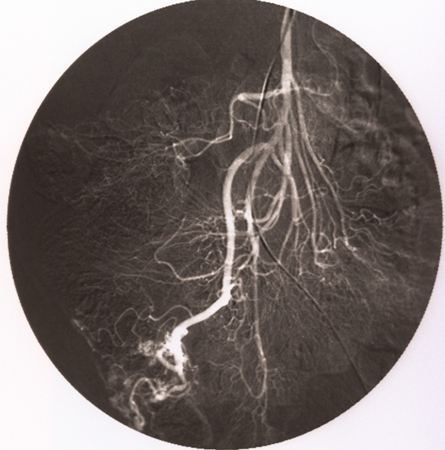Resumen
Definición
Anamnesis y examen
Principales factores de diagnóstico
- gastrointestinal bleeding
Otros factores de diagnóstico
- age >60 years
- shortness of breath
- fatigue
- pallor
- tachycardia
- hypotension
Factores de riesgo
- chronic renal failure/end-stage renal disease
- von Willebrand disease
- aortic stenosis
- scleroderma
- cardiovascular disease
- increasing age
Pruebas diagnósticas
Primeras pruebas diagnósticas para solicitar
- CBC
- blood type and crossmatch
- blood chemistry
- coagulation status
- esophagogastroduodenoscopy
- push enteroscopy
- colonoscopy
Pruebas diagnósticas que deben considerarse
- wireless capsule enteroscopy
- CT angiography
- selective mesenteric angiography
- technetium Tc-99m radionuclide scan
- CT enterography
- device-assisted enteroscopy
Pruebas emergentes
- magnetic resonance angiography
Algoritmo de tratamiento
hemodynamically unstable (severe hemorrhage)
hemodynamically stable
recurrent bleed
Colaboradores
Autores
Reena Sidhu, MD, FRCP
Consultant Gastroenterologist
Royal Hallamshire Hospital
Sheffield Teaching Hospitals NHS Foundation Trust
Hon Professor
Division of Clinical Medicine
School of Medicine and Population Health
University of Sheffield
Sheffield
UK
Divulgaciones
RS has received speaker fees and congress travel grants (Dr Falk 2021 & 2023). RS has attended ANx Robotica symposium 2023. RS is an author of a reference cited in this topic.
Nicoletta Nandi, MD
Clinical Fellow
Academic Unit of Gastroenterology
Sheffield Teaching Hospitals NHS Foundation Trust
Sheffield
UK
Divulgaciones
NN declares that she has no competing interests.
Agradecimientos
Prof Reena Sidhu and Dr Nicoletta Nandi would like to gratefully acknowledge Dr Aidan Shaw, Dr Heather Lee, and Dr William Speake, previous contributors to this topic.
Divulgaciones
AS, HL, and WS declare that they have no competing interests.
Revisores por pares
Brooks D. Cash, MD, AGAF, FACG, FACP, FASGE
BMJ Best Practice Gastroenterology expert panel member
Professor of Medicine
University of Texas Health Science Center at Houston
Houston
TX
Disclosures
BDC declares that he has no competing interests.
Peer reviewer acknowledgements
BMJ Best Practice topics are updated on a rolling basis in line with developments in evidence and guidance. The peer reviewers listed here have reviewed the content at least once during the history of the topic.
Disclosures
Peer reviewer affiliations and disclosures pertain to the time of the review.
References
Key articles
Gerson LB, Fidler JL, Cave DR, et al. ACG clinical guideline: diagnosis and management of small bowel bleeding. Am J Gastroenterol. 2015 Sep;110(9):1265-87; quiz 1288.Full text Abstract
Sengupta N, Kastenberg DM, Bruining DH, et al. The role of imaging for GI bleeding: ACG and SAR consensus recommendations. Radiology. 2024 Mar;310(3):e232298. Abstract
Triantafyllou K, Gkolfakis P, Gralnek IM, et al. Diagnosis and management of acute lower gastrointestinal bleeding: European Society of Gastrointestinal Endoscopy (ESGE) guideline. Endoscopy. 2021 Aug;53(8):850-68.Full text Abstract
Reference articles
A full list of sources referenced in this topic is available to users with access to all of BMJ Best Practice.

Differentials
- Diverticular disease
- Colorectal cancer
- Gastrointestinal stromal tumors and leiomyomas
More DifferentialsGuidelines
- The role of imaging for GI bleeding: ACG and SAR consensus recommendations
- Management of patients with acute lower gastrointestinal bleeding
More GuidelinesLog in or subscribe to access all of BMJ Best Practice
Use of this content is subject to our disclaimer